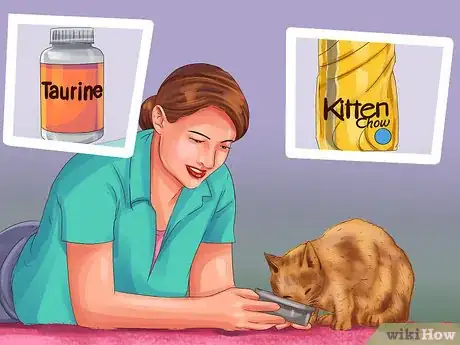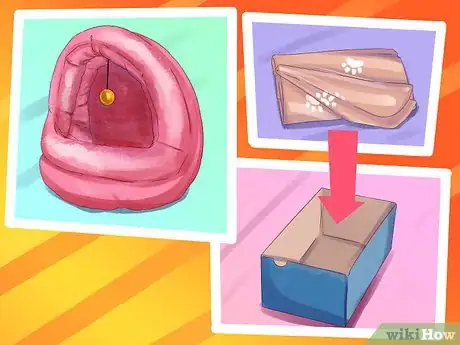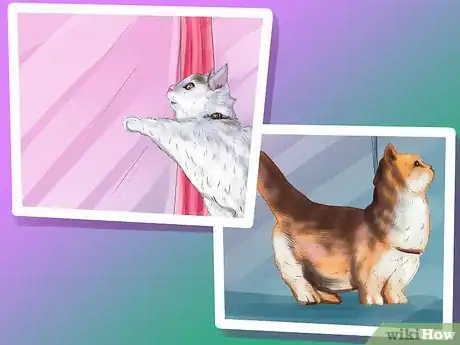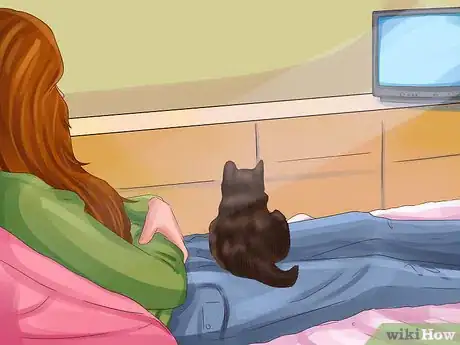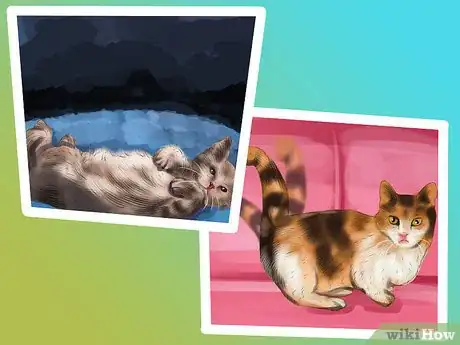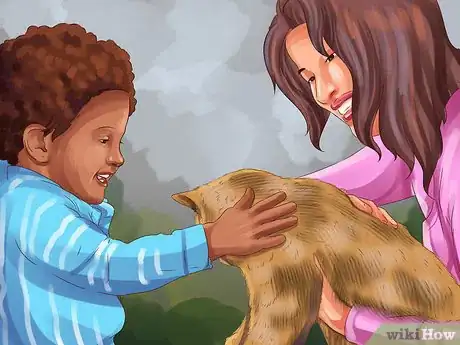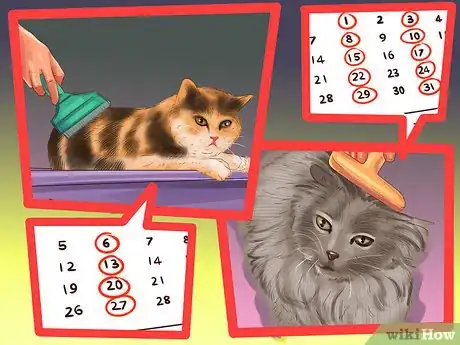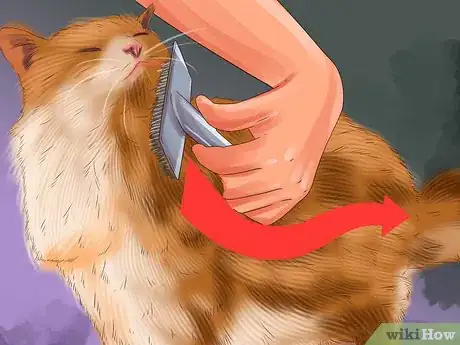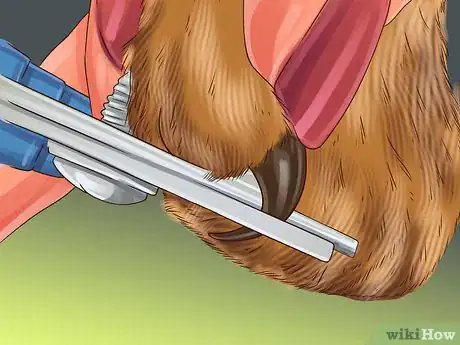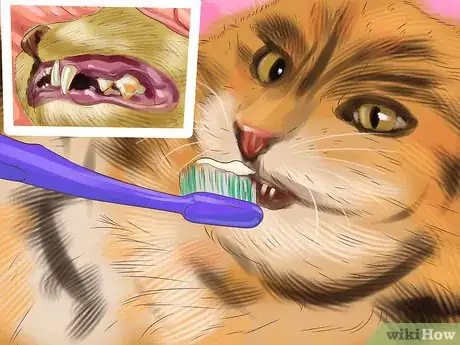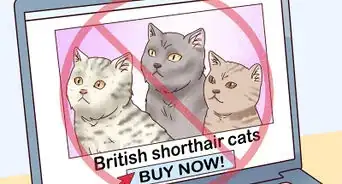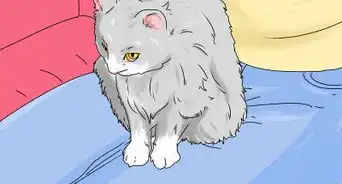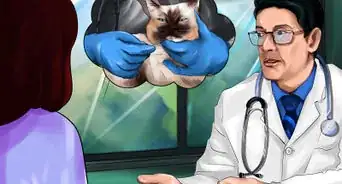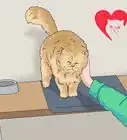This article was co-authored by Pippa Elliott, MRCVS. Dr. Elliott, BVMS, MRCVS is a veterinarian with over 30 years of experience in veterinary surgery and companion animal practice. She graduated from the University of Glasgow in 1987 with a degree in veterinary medicine and surgery. She has worked at the same animal clinic in her hometown for over 20 years.
There are 7 references cited in this article, which can be found at the bottom of the page.
wikiHow marks an article as reader-approved once it receives enough positive feedback. In this case, 94% of readers who voted found the article helpful, earning it our reader-approved status.
This article has been viewed 61,438 times.
Munchkin cats are named because they have short, stubby legs. Despite their short stature, Munchkin cats can move and run as fast as any other cat. However, due to the fact they have difficulty reaching high places, it's best to keep them indoors and away from predators. Keep your munchkin cat healthy with a good diet, fresh water, and a clean litter box. Make sure your cat gets plenty of attention. Munchkin cats are highly social. While munchkin cats don't require much special care, regular brushing is important to keep their fur free of tangles.
Steps
Keeping Your Munchkin Cat Healthy
-
1Feed your munchkin a healthy diet. Munchkin cats, like any cat, require a healthy diet. However, they do not need food specifically made for munchkin cats. You can feed them any nutritious, veterinary recommended brand of cat food.[1]
- Select a food specifically made for cats. You cannot feed cats using human foods, such as chicken or tuna, as cats need a specific vitamin called taurine for their health. Taurine is found in commercial cat foods.
- Kittens need a specific formula of food in order to promote growth and health. If your munchkin is a kitten, make sure to feed it kitten chow.
- You can give your munchkin treats if you want, but make sure treats do not make up more than 5 to 10% of your cat's diet.
- The only special consideration to take with munchkins is whether they can reach their food. Due to their small height, munchkins may have trouble jumping onto high places. Make sure your munchkin's food is within its reach.
-
2Make sure your munchkin has access to fresh drinking water. Like any animal, you need to keep a clean bowl of fresh drinking water out for your munchkin at all times. Keep an eye on your cat's water bowl, and refill it as needed. You should also make sure the water bowl is in an area a munchkin can easily reach.[2]Advertisement
-
3Provide bedding. Cats will need beds to feel comfortable. Make sure you keep your house full of warm, comfortable places for your cat to curl up.[3]
- You can buy a bed at a pet store and line it with warm blankets. You can use an old object from your home, such as an old shoebox, as your cat's bed. If you have multiple cats, set out multiple beds.
-
4Keep your munchkin cat indoors. In general, most cats do better indoors. Indoor cats tend to live longer.[4] Munchkins especially will not do well outdoors. Their short stature will make them an easy target for predators. Munchkins are best raised as indoor cats.[5]
- If your munchkin really wants to go outside, you can try letting it out in supervised settings. You can also buy a harness for your munchkin and take it on short walks.
-
5Maintain a clean litter box. You should scoop out a cat's litter box every day. Once a week, empty all the litter and then wash the litter box with mild detergent. After the box is dry, add a fresh layer of litter.[6]
- Lemon-scented cleaners, or cleaners with deodorants and ammonia, should not be used in a litter box. These scents can bother cats, and your cat my not use its litter box if you use these kinds of cleaners.
-
6Take your cat to the vet regularly. Like all cats, munchkins need regular vet check ups. Take your cat to the vet at least once a year and keep it up to date on vaccinations. Keep in mind kittens may need more frequent vet visits than adult cats.[7]
- In general, the munchkin is a fairly healthy breed. However, they do have a slight genetic predisposition to abnormalities of the spine and chest. Your vet should be able to detect such abnormalities and recommend a treatment plan.[8]
Socializing Your Cat
-
1Provide shiny and movable toys. Munchkins love shiny toys, and may bury such toys around the house. They also love things they can chase. Make a stop at your local pet store and get your munchkin toys it will like.[9]
- Look for brightly colored, reflective cat toys. Your munchkin will be attracted to these.
- Small toys your munchkin can bat around, such as tiny mice, are also a good option.
- Mechanical or moving toys can also be great for a munchkin, but remember not to let your cat use them unsupervised.
-
2Snuggle with your munchkin regularly. Munchkins are a very social breed of cat. Make sure you take some time at the end of each day to let your munchkin snuggle with you. Allow your munchkin to sit on your lap while you watch TV or read a book, for example.[10]
-
3Pay attention to cat body language. Like any animal, you should make sure your munchkin is comfortable with you. Work on reading a munchkin's body language. If you're doing anything that makes your cat uncomfortable, cease the behavior. This will help your munchkin be comfortable around you and more social overall.[11]
- A munchkin with forward ears, an erect tail, a back arched with flat fur indicates your cat is happy. It may also lie on its back or side and purr to indicate happiness. It is probably safe to pet a munchkin in such a state.
- However, backwards ears, dilated pupils, hair that stands up, and tail that's trashing back and forth indicate your cat is agitated. Leave it alone when it's in this state.
-
4Teach young children to handle munchkin cats with care. Munchkins are great family pets and can get along well with children. However, make sure your children know how to handle a cat. You want your munchkin to have positive experiences with young kids.[12]
- Explain cat body language to your children. Make sure your children know when a cat wants to be left alone. Encourage them to respect a cat's boundaries.
- Discourage your kids from over-handling or taunting animals. Instead, show them how to pet your munchkin in a gentle fashion.
Grooming a Munchkin Cat
-
1Learn how often to brush your munchkin cat. Munchkin need regular brushing. How often you brush your cat depends on the type of munchkin you own.[13]
- A shorthaired munchkin should be brushed once a week.
- A longhaired munchkin should be brushed at least twice a week.
-
2Brush your munchkin cat regularly. Make sure to make brushing a positive experience, as you'll need to brush your cat regularly. Wait until your munchkin is in a good mood to approach it for brushing.[14]
- For a shorthaired cat, work from the head to the tail. Work along the natural line of the coat. Make sure to brush the full body, including areas like the chest and abdomen.
- For a long haired cat, comb the legs and abdomen against the natural direction of the hair. Make a part down the cat's back and then comb each side.
- Always reward your cat with praise or treats after it behaves while being brushed.
-
3Trim your munchkin cat's nails regularly. Like all cats, munchkins need their nails trimmed. When a cat's nails begin to get long, to the point the cat's getting stuck on furniture, trim its nails.[15]
- Pick your cat up and gently take one of its paws. Push down on the pad of your cat's paw to extend the nails.[16]
- Clip just the tip of each nail. Make sure to only cut into the white part of the claw. The pink part is known as the quick, and will bleed if you cut it.
- Reward your cat after clipping its nails with treats or praise.
-
4Ask your vet about brushing your cat's teeth. Munchkins need their teeth brushed on a regular basis as well. Make sure to ask your vet first, as you want a brand of toothpaste that's safe for your cat.[17]
- If your cat is not used to having its teeth cleaned, gently massage its gums to get it used to having its mouth handled. Then, put some of the toothpaste on the cat's lips so it gets used to the taste.[18]
- You usually use a small, cat-sized toothbrush to brush your cat's teeth. Gently apply the toothpaste to your cat's teeth to remove tartar and other bacteria.
References
- ↑ http://www.aspca.org/pet-care/cat-care/general-cat-care
- ↑ http://www.catbreedsjunction.com/munchkin-cat.html
- ↑ http://www.aspca.org/pet-care/cat-care/general-cat-care
- ↑ http://www.aspca.org/pet-care/cat-care/general-cat-care
- ↑ http://www.catbreedsjunction.com/munchkin-cat.html
- ↑ http://www.aspca.org/pet-care/cat-care/general-cat-care
- ↑ http://www.aspca.org/pet-care/cat-care/general-cat-care
- ↑ http://www.catbreedsjunction.com/munchkin-cat.html
- ↑ http://www.petmd.com/cat/breeds/c_ct_munchkin
- ↑ http://www.petmd.com/cat/breeds/c_ct_munchkin
- ↑ http://www.humanesociety.org/animals/cats/tips/cat_communication.html
- ↑ http://ripplekindness.org/5-tips-for-teaching-children-to-be-kind-to-animals/
- ↑ http://www.vetstreet.com/cats/munchkin#grooming
- ↑ http://www.aspca.org/pet-care/cat-care/cat-grooming-tips
- ↑ http://www.vetstreet.com/cats/munchkin#grooming
- ↑ http://www.aspca.org/pet-care/cat-care/cat-grooming-tips
- ↑ http://www.vetstreet.com/cats/munchkin#grooming
- ↑ http://www.aspca.org/pet-care/cat-care/cat-grooming-tips
About This Article
To care for a munchkin cat, keep it indoors since its small size could make it an easy target for predators. In order to keep your cat entertained indoors, give it shiny and movable toys that it can chase and bury around the house. You’ll also want to give your munchkin plenty of attention since it is a social breed, so let it snuggle with you or sit in your lap while you work or read a book. If you have a shorthaired munchkin, you'll only need to groom it once a week, but if you have a longhaired munchkin, you’ll want to groom it at least twice a week. For more tips from our Veterinary co-author, including how to feed your munchkin, keep reading!
